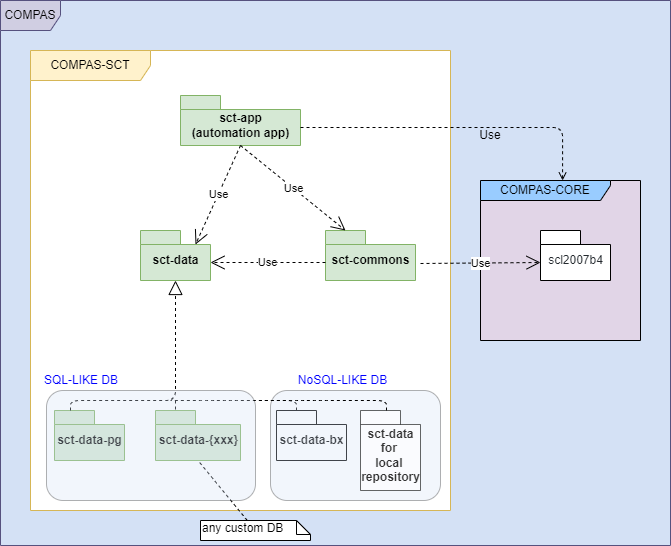Currently v0.2.3
© 2023. All rights reserved.
The CoMPAS SCT (System Configuration Tool) is part of the CoMPAS (Configuration Module for Power System Automation) ecosystem which is an open source project aimed at providing a tool for configuring control system and profile management related to the 61850 standard. Its architecture allows an easy integration with the other components of CoMPAS, in addition to being modular and flexible with a high level of abstraction, it gives the freedom to implement the tool with the database of its choice.
The below package diagram shows different part of the tool architecture.

Hence, we can distinguish four major parts:
This package holds a light weight and configurable XML binding tool based on the JAXB utilities, and set of bound SCL objects adapter. Actually the JAXB generated SCL objects can only be read through from the parent tag to child tag. That can be very limiting. The adapter concept allows:
The SCT services specification of the norm IEC 61850 will be implemented in this package.
The Approach behind the SCL adapter is to complete the navigation provided by the JAXB tool, by adding functionalities that allow the browsing upward (from child to any ancestor). The conception is based on the abstraction defined below :
public abstract class SclElementAdapter<P extends SclElementAdapter, T> {
protected P parentAdapter;
protected T currentElem;
protected SclElementAdapter(P parentAdapter) {
this.parentAdapter = parentAdapter;
}
protected SclElementAdapter(P parentAdapter, T currentElem) {
if(currentElem == null){
throw new IllegalArgumentException("The SCL element to adapt must be defined");
}
this.parentAdapter = parentAdapter;
this.customInit();
setCurrentElem(currentElem);
}
protected boolean amRootElement(){
return parentAdapter == null;
}
protected void customInit() {
// do nothing
}
public final void setCurrentElem(T currentElem){
this.currentElem = currentElem;
if(!amRootElement() && !amChildElementRef()){
throw new IllegalArgumentException("No relation between SCL parent element and child");
}
}
protected abstract boolean amChildElementRef();
}
The root element adapter (entry point) is special as it does not have any parent adapter, hence, its method amChildElementRef(T)
should always return true:
public class SclRootAdapter extends SclElementAdapter<SclRootAdapter, SCL>{
private version;
private revision;
private release;
public SclRootAdapter(SCL currentElem) {
super(null, currentElem);
//set version, release & revision
}
public SclRootAdapter(String hId, String hVersion, String hRevision){
super(null);
this.currentElem = initialize(hId,hVersion,hRevision);
}
@Override
protected boolean amChildElementRef(SCL sclElement) {
return true;
}
[...]
}
Data models and connectivity to database are defined here. Data access layer is an abstract layer that defined connectivity interfaces. This layer manages a database with single table (SQL-Like database) or single collection (NoSQL-Like database). The concrete data access layers are implemented in specific packages. A data model can implement the following interface
public interface IScd <ID> {
ID getId();
byte[] getRawXml();
ID getHeaderId();
String getHeaderRevision();
String getHeaderVersion();
String filename();
}
An implementation of the sct-data connectivity interface with custom data models. This allows the application to work with sql-like database. The libraries ares use for SQL-Like databases, those that support XML type (PostgreSql, Oracle, etc)
Like SQL-like part, this package contains the sct-data connector interfaces implementation for NoSQL-Like databases (BaseX, existDB, etc ) that support XML processing.
This can also be a local repository connector (file system). For example, with meta-data headerID, headerVersion, headerRevision and filename one can implement the connector to have the below output (with the constraint of having a single file in /pathTo/headerId/headerVersion/headerRevision):
myRepo
├───<headerID>
│ ├───<headerVersion1>
│ │ └───<headerRevision1>
│ │ | ├───<fileName1.scd>
│ │ └───<headerRevision2>
│ │ ├───<fileName2.scd>
TODO
In progress
For large SCL file, it is not a good idea to load the whole file in memory. JAXB is capable of processing XML file by chunks. The need to load the whole SCL file relies on the fact that XML validation processes needs the entire file content. To go through that process we must take advantage of the XSD constraints and build minimal SCL file from the large one. The most “important” tags in the SCL file are: Header, Substation, Communication, IED and DataTypeTemplate. By looking closely in the XSD file, one can realize the below dependencies’ logic :
Hence, with this in mind, one can reconstruct a minimal SCL file by focusing on the chunk of interest then realize creation/update operations on the file and validate it against the XSD file.
For example: Updating IED
From SCD header’s information, create a minimal valid SCD file
<SCL version="2007" revision="B" release="4" xmlns="http://www.iec.ch/61850/2003/SCL">
<Header id="hId" version="2007" revision="B" toolID="COMPAS"/>
</SCL>
As IED depends on DataTypeTemplate, extract the IED chunk with the whole DataTypeTemplate chunk from the large file and import it in the temporary SCD file
<SCL version="2007" revision="B" release="4" xmlns="http://www.iec.ch/61850/2003/SCL">
<Header id="hId" version="2007" revision="B" toolID="COMPAS"/>
<IED name="IED_NAME">
<AccessPoint>....</AccessPoint>
</IED>
<DataTypeTemplate>....</DataTypeTemplate>
</SCL>
Operations can now be realized and validated on this minimal file (which has the same structure as an ICD file). Any validation on the minimal file guaranties a valid integration of those chunks into the large file.
WARNING: This concern only update/creation operations on SCL file.
Operations on the tag Substation are not complicated (those are similar to SSD files).
For Communication tag, a minimal valid IED tag with child tag Access point can suffice. If the IED’s logical nodes are concerned in the process, one should think of bringing along the DataTypeTemplate chunk.
<SCL xmlns="http://www.iec.ch/61850/2003/SCL" version="2007" revision="B" release="4">
<Header id="cccc"></Header>
<Communication>
<SubNetwork name="tt">
<ConnectedAP iedName="IED" apName="AP"></ConnectedAP>
</SubNetwork>
</Communication>
<IED name="IED"> <!-- minimal valid IED to avoid using DataTypeTemplate-->
<AccessPoint name="AP"></AccessPoint>
</IED>
</SCL>
Combination like this can heavily optimize memory consumption while manipulating large SCD file.